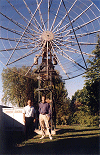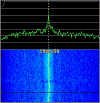|
The GPS 1575.42 MHz L1 C/A +14.3 dBW carrier (see above) is spread by a 1.023 MHz chipping rate pseudo random code. This chipping rate results in a bandwidth of 2.046 MHz. By contrast, the 1227.6 MHz L2 P code signal (seen here) is modulated on a +8.1 dBW carrier at a 10.23 MHz chip rate with a resultant bandwidth of 20.46 MHz. Thus, the L2 signal is 16 dB weaker than the L1, and a real test of a SETI station's sensitivity. This L2 detection was made at Argus Station FN11LH. Note that the signal passes first through the antenna's main lobe, and then through the first sidelobe. (Sidelobe response was far greater than expected, indicating a need for repositioning of the feedhorn.)
GPS technical specs provided by Dr. Art Lange, W6RXQ, of Trimble Navigation.
|
 SETI League Photo Gallery
SETI League Photo Gallery


































